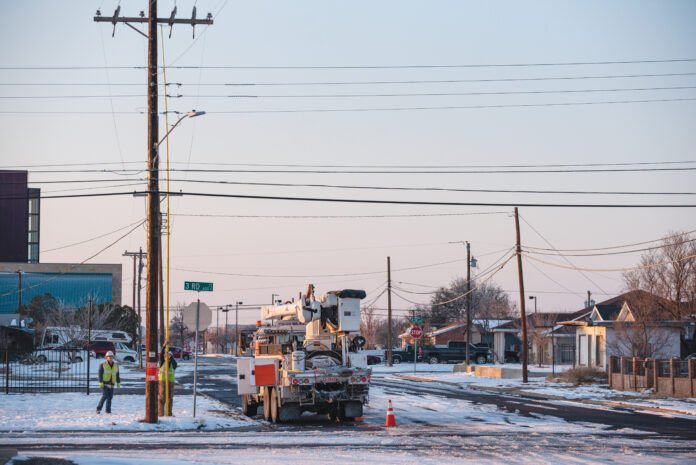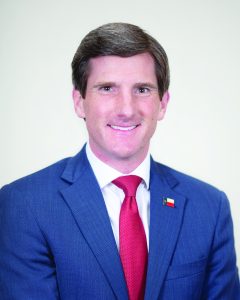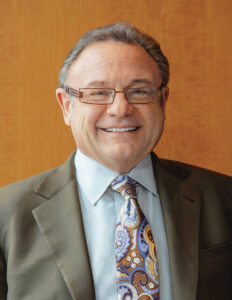
The state needs to start stringing power lines and fast because their inadequacy is one of the biggest challenges to handling another Winter Storm Uri.
Buoyed by the $33-billion surplus that the energy industry has handed it, the Texas House and Senate find themselves confronted with 10 percent of the state’s population not being reached by the power grid and serious doubts about some of the areas that it does.
State Rep. Brooks Landgraf, R-Odessa, and Waco economist Ray Perryman say the situation is worrisome.

“Texas does not have enough high-voltage transmission lines to handle the grid,” said Landgraf, chairman of the House Environmental Regulation Committee in Austin. “The state’s power grid is growing rapidly, but the transmission lines are not keeping pace.
“This is causing congestion, which can lead to outages. In addition, the grid is not well-prepared for extreme weather events like the winter storm that caused widespread outages in February 2021.”
The Electric Reliability Council of Texas (ERCOT), which manages the grid, says Texas has about 46,500 miles of high-voltage lines that supply power to the 26 million customers who represent 90 percent of the state’s electric load.
Landgraf said Tuesday that the Legislature “needs to invest in more transmission lines to improve the reliability of the grid, make it more resilient to extreme weather events and ensure that Texans have reliable access to electricity.
“We need to increase the capacity of existing lines, build new lines and make the grid more resilient to extreme weather events,” he said.
San Angelo Republican Rep. Drew Darby’s House Bill 1254 would facilitate a timely and targeted expansion of the grid, resolve existing interzonal and intrazonal transmission constraints and ensure the future reliability of ERCOT by prioritizing the addition of load-serving capability in high growth areas and require new lines operating at 345 kilovolts to be constructed as double circuit capable lines, among numerous other provisions.
ERCOT reaches 213 of the state’s 254 counties with the other 41 being served by various companies in far West Texas, far East Texas, the western South Plains and the upper Panhandle. Those 41 are Bailey, Bowie, Camp, Cass, Cochran, Dallam, El Paso, Gaines, Gregg, Hansford, Hardin, Harrison, Hartley, Hemphill, Hockley, Hudspeth, Hutchinson, Jasper, Jefferson, Lamb, Liberty, Lipscomb, Lubbock, Marion, Moore, Morris, Newton, Ochiltree, Orange, Panola, Polk, Sabine, San Augustine, San Jacinto, Shelby, Sherman, Terry, Trinity, Tyler, Upshur and Yoakum.
Winter Storm Uri knocked off the electricity in 4 1/2 million Texas homes and businesses while costing $295 billion and killing 200 people.

Perryman said Tuesday that capacity issues “are clearly emerging and both ERCOT and the Public Utilities Commission of Texas are monitoring the situation,” particularly in West Texas, which has had repeated transmission problems.
Noting that the statewide system has more than 86,000 megawatts of available generation capacity, Perryman said the ERCOT-affiliated transmission and distribution utility companies or TDUs maintain the lines.
“TDUs are investor-owned and are responsible for maintaining the infrastructure that delivers power to the end-use consumer including high-voltage transmission lines, substations, local distribution lines and consumer meters,” he said. “Additional transmission capacity may be needed due to growth in demand such as with population expansion or industrial development.
“For example, certain industries lead to a need for additional power whether crypto-mining, oilfield activity, data centers or some types of manufacturing that require extensive power. Changes in generation can also lead to incremental needs such as large wind and solar developments.”
Perryman said ERCOT is aware of issues emerging in West Texas from both the demand and supply sides. “A recent report says oil and gas extraction and processing in West Texas have led to record growth in electricity demand in this area,” he said.
“In addition to demand for electricity, West Texas continues to see the growth of renewable generation resources. These factors have all contributed to transmission congestion in the West Texas region.”
The economist said five of the 10 most frequent transmission constraints in 2021 were in the West Texas load zone. “The PUCT has been engaged with both utilities and consumers to ensure that electric service quality remains reliable and to examine options for improved load forecasting and transmission planning,” he said.
“Utilities that serve the West Texas region continue to build new infrastructure to serve the demand.”
Perryman said the market should be able to meet the need for additional transmission capacity “assuming that the rates of return, which are still regulated for that aspect of the power system, are sufficient to induce the required capital investment.
“The situation in West Texas has been changing rapidly and the ongoing growth in renewables will further enhance the need and hence the likelihood of a TDU (Transmission and Delivery Utility) stepping in to build the necessary lines,” he said. “Prior to the creation of the competitive market, regulated utilities handled generation, transmission and distribution.
“For most of the ERCOT area, competition was implemented for generation and retail distribution a number of years ago, but transmission remained regulated because it is a natural monopoly in that it doesn’t make sense to have multiple power lines running down or under the same street,” Perryman said.
“I have worked on the economics of such projects both before and since much of the power system was converted to a market including the major investment in the Competitive Renewable Energy Zone initiative, which essentially allowed the movement of power from the places where the wind blows and the sun shines to the places where the people live.
“There are many challenges facing grid operators, some of which were dramatically exposed during Winter Storm Uri. With regard to transmission lines, however, the major issue is simply assuring that the TDUs can receive adequate returns to incentivize the needed investment.”



